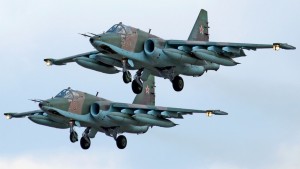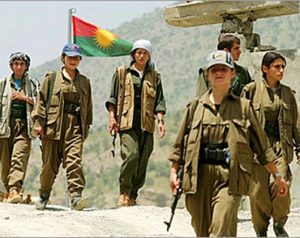Is Iran wading deeper into the Euphrates?
Brian M Downing
Over the years, since the Assad government crushed peaceful calls for reform, foreign power after foreign power has intervened with money or arms or troops – Western and Middle Eastern, Shia and Sunni, Arab and Persian.
Iran has sent money, arms, and troops, and taken remarkably high casualties. Its Russian ally has shown less commitment by withdrawing over half of its aircraft from Syria, leaving Tehran in a quandary over sending in more troops. What risks does Iran face if it escalates? What risks does it face if it doesn’t? What powers want it to wade deeper still?
Syria in Iranian national security
 Shia-Sunni animosities are at their highest level in centuries, perhaps the worst since the 7th-century battles formed lasting enmity. The Shia see themselves as an outnumbered but righteous people who have endured Sunni oppression and hatred. Present events resonate with venerated myths. The ouster of the shah, Iranian nuclear efforts, and spreading chaos in the region have intensified sectarian conflict, especially between Iran and Saudi Arabia.
Shia-Sunni animosities are at their highest level in centuries, perhaps the worst since the 7th-century battles formed lasting enmity. The Shia see themselves as an outnumbered but righteous people who have endured Sunni oppression and hatred. Present events resonate with venerated myths. The ouster of the shah, Iranian nuclear efforts, and spreading chaos in the region have intensified sectarian conflict, especially between Iran and Saudi Arabia.
If the Syrian rebels, backed by the Gulf powers, are successful, Iran will lose a valuable ally and the Shias in Lebanon may be reduced to the isolated minority they were 35 years ago. Iran will be alone, save for Shia Iraq which is increasingly chaotic and beleaguered by ISIL and secessionism.
Iran’s commitment
When Assad’s rule tottered, Iran sent money and arms. Advisers soon followed, serving with Syrian troops and organizing Shia-Alawi militias. As the war dragged on, Iran recruited Shia fighters from Afghanistan and Iraq and formed them into international battalions.  Late last year, IRGC troops were deployed in conjunction with Russian air support.
Late last year, IRGC troops were deployed in conjunction with Russian air support.
The results have been unimpressive; the vaunted IRGC troops and Russian air cover failed to turn the tide. Putin has withdrawn much of his air power and shifted, apparently, to brokering a settlement rather than serving in Assad’s, and possibly Iran’s, unrealistic and open-ended schemes of reconquest.
Iran’s expenditures in Syria are significant but probably not crushing. Sanctions are coming off and trade is returning. However, oil prices are low and expected to remain so, and Iran is also funding the Houthis in Yemen and Hamas in Gaza. Nonetheless, the need for an ally in Syria makes further commitment essential to national security.
Iranian casualties have been steep – approximately 375 killed, most of them since the counteroffensive began last fall. That isn’t high for a country of 75 million, but it is remarkable for a troop level of about 2,000: twenty percent killed and certainly several times that wounded and missing. This suggests that IRGC troops have been spearheading drives and/or have been targeted by rebel forces and international backers.
 Tehran is probably seeing that casualties do not fall heavily on restive minorities, but chiefly on the Persian majority. The casualties are unlikely to cause discontent as the war enjoys support for defending both nation and faith.
Tehran is probably seeing that casualties do not fall heavily on restive minorities, but chiefly on the Persian majority. The casualties are unlikely to cause discontent as the war enjoys support for defending both nation and faith.
The IRGC’s lackluster performance comes as a surprise to many observers. They were seen as highly-motivated and well-trained by Russian cadres over many years, and no longer the fervent youths who took horrific and needless casualties against Iraq in the 80s. Iranian troops may be little better than other forces in the region. Feeling exposed to enemies, Tehran may feel the need for the IRGC to firm up in battle, possibly with greater troops levels.
Observers will watch with great interest to see if it can firm up. So will Iran’s many enemies in the region. So will the Kurds and Baluchs and Arabs inside the country who are looking for their opportunity.
Sunni adversaries
Saudi Arabia, other Sunni powers, and Israel as well will want to see Iran plunge deeper into Syria. The Sunnis can increase money and arms to rebels and encourage them to concentrate on Iranian soldiers. Israel will continue its intermittent strikes on Iranian troops  and their Shia militias, especially Hisbollah.
and their Shia militias, especially Hisbollah.
Iran’s foes may also encourage restive minorities such as the Kurds and Balochs and Arabs to step up resistance to Persian authority. The goal, which may be farfetched, is that Iran will face the internal conflicts that have already broken down several Middle Eastern countries – Libya, Syria, Iraq, and Yemen.
Iran might come out very much the loser if escalation continues. The Syrian people, so eager for an end to the war, undoubtedly will.
Copyright 2016 Brian M Downing
Brian M Downing is a national security analyst who has written for outlets across the political spectrum. He studied at Georgetown University and the University of Chicago, and did post-graduate work at Harvard’s Center for International Affairs.